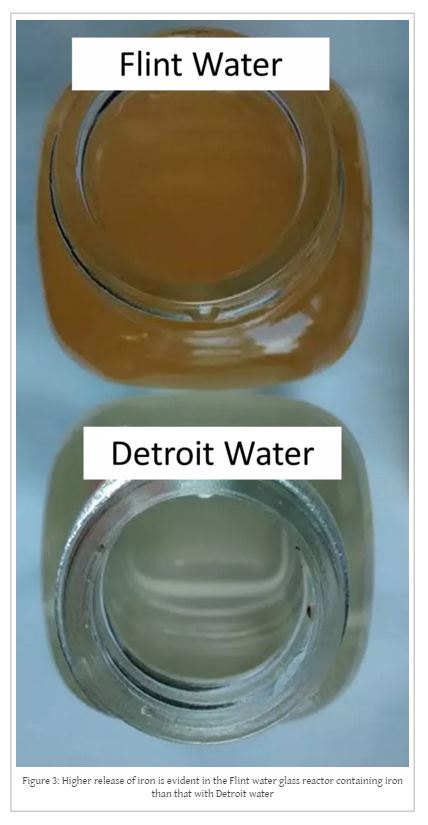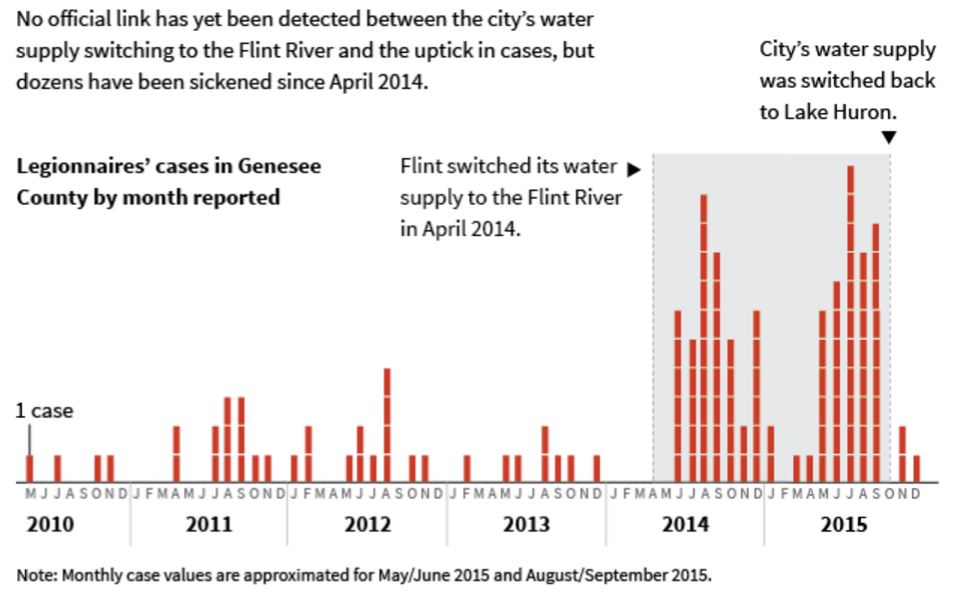The Circumstantial Case for Flint River Water and Hot Water Tanks Leading to Flint’s Legionnaires’ Oubreak
Although the progressive community has been aware, for more than a year, of the water quality crisis in Flint that was created when the state-appointed emergency manager switched Flint from Detroit’s water system to a supply from the nearby Flint River, national attention is only now starting to focus on it. Today’s New York Times features an editorial denouncing the “depraved indifference” Governor Rick Synder’s administration showed toward Flint as the crisis unfolded.
The basics of what happened are clear. Water from the Flint River is much more corrosive than that from the Detroit water system (from Lake Huron). Even though this water leaves the Flint processing facility fairly clean and appearing to meet most standards, its corrosive nature results in the pipes in the aged Flint distribution system corroding. Both iron and lead leach into the water as a result of this corrosion, leaving the water with a reddish-orange tint and unsafe levels of lead. Children in the area have already shown elevated levels of lead in their systems. Sadly, lead damage is irreversible.
A bit of digging shows that the corrosive nature of the Flint River water comes from its high chloride content. [Note: free chloride ions (Cl–) are distinct from intact molecular chlorine (Cl2) and have very different chemical effects in the systems being described here. For brevity, they will be referred to as chloride and chlorine, respectively.] That high chloride content very likely results from heavy application of salt to roads during winter and subsequent runoff of the salt into tributaries and the river. The Flint River has a chloride content about eight or nine times higher than Lake Huron.
Technical documentation of the Flint water crisis is almost entirely the work of a group of researchers directed by Professor Marc Edwards of the Department of Civil and Environmental Engineering at Virgina Tech (frequently updated at their website, flintwaterstudy.org). As the Times editorial noted, the Snyder administration tried to dismiss one group of critics as “anti-everything”. That won’t work with Edwards, who won a MacArthur Foundation Fellowship (often called a Genius Grant) in 2007 for his work on water quality.
One very simple and elegant study carried out by Edwards and his team is described in this post from August 24 of last year. The team took a clean-looking sample of Flint water and put it into a glass jar along with a piece of iron. The iron is present to mimic the effect of the Flint water coming into contact with iron pipes as it flows through the distribution system into people’s homes. An otherwise identical sample was prepared with water that came from the Detroit water system. After only five days, the jars looked dramatically different:

Flint water that has been in the presence of iron for five days takes on a reddish-orange cast while Detroit water does not. Image is Figure 3 found at http://flintwaterstudy.org/2015/08/why-is-it-possible-that-flint-river-water-cannot-be-treated-to-meet-federal-standards/ by Dr. Marc A. Ewards and Siddhartha Roy.
The water in the Flint jar looks just like what we have seen in countless photos of exasperated Flint residents wanting something done about the poor quality of the water coming out of their taps. Leached iron by itself could well be the cause of this discoloration that is common in Flint. We will come back to this same study in a bit.
In addition to the dire issue of unsafe lead levels in homes (and subsequently documented in children) that received Flint River water, another problem may relate to the changed water source. Writing at Huffington Post earlier this week, Erin Schumaker documented an outbreak of Legionnaires’ Disease in Flint. Remarkably, in a graphic created by Alissa Scheller, we see that the outbreak coincides quite precisely with the change in water source:

Huffington Post graphic depicting Legionnaires’ Disease cases in Flint and their correlation with the water source. Link: http://www.huffingtonpost.com/entry/flint-water-legionnaires-lead-crisis_us_569d09d6e4b0ce4964252c33 Graphic by Alissa Scheller.
How could there be a pathway connecting the water source to a Legionnaires’ outbreak? Read more →
